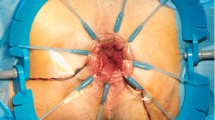Abstract
The disappearance and subsequent return of the recto-anal inhibitory reflex following low anterior resection was investigated using manometric and histological studies. Ten female greyhound dogs were randomised into 2 groups. All underwent low anterior resection. Five had stapled EEA anastomosis of the rectum and 5 were handsewn. The recto-anal inhibitory reflex was measured before and after surgery using a microtransducer tipped catheter. Six months postoperatively the recto-anal inhibitory response was again measured and the animals sacrificed. The colorectal anastomoses were examined histologically using light microscopy to determine the pattern of innervation at the anastomotic site. Manometric studies showed the recto-anal inhibitory reflex present in all cases pre-operatively, in only 1 case on the tenth postoperative day and was present in eight cases after 6 months. Histological examination of longitudinal sections across the anastomoses showed clear evidence of regenerating nerve trunks at the anastomotic site in both stapled and handsewn groups. We conclude that the return of the recto-anal inhibitory reflex is associated with regeneration of intramural autonomic nerves across the anastomotic scar.
Résumé
La disparition et le retour du reflexe rectoanal inhibiteur après résection antérieure basse a été étudiée manométriquement et histologiquement. 10 chiens lévtiers femelles ont été randomisés en deux groupes. Tous ont subi une résection antérieure basse. 5 avaient une anastomose à la pince EEA et 5 une anastomose manuelle. Le réflexe rectoanal inhibiteur a été mesuré avant et après la chirurgie utilisant un cathéter surmonté par un capteur de pressions. 6 mois après l'opération, le réflexe rectoanal inhibiteur, était de nouveau mesuré et les animaux sacrifiés. L'anastomose colorectale était examinée histologiquement à l'aide d'un microscope pour déterminer l'aspect de l'innervation au niveau anastomotique. Les études manométriques montraient que le reflexe rectoanal inhibiteur, était présent dans tous les cas avant l'opération et seulement dans 1 cas au dixième jour postopératoire mais dans 8 cas après 6 mois. Les examens histologiques de section longitudinale à travers l'anastomose montraient clairement l'évidence de tronc nerveux de régénération dans la région anastomotique à la fois dans le groupe anastomose mécanique et manuelle. Nous concluons que le retour du reflexe rectoanal inhibiteur est associé avec une régénération des nerfs autonomes intramuraux à travers la cicatrice anastomotique.
Similar content being viewed by others
References
Gowers WR (1877) The automatic action of the sphincter ani. Proc R Soc (Lond) 26:77–84
Duthie HL, Gairns FW (1960) Sensory nerve endings and sensation in the anal region of man. Br J Surg 47:585–595
Duthie HL, Bennett RC (1963) The relation of sensation in the anal canal to the functional anal sphincter: a possible factor in anal continence. Gut 4:179–182
Lubowski DZ, Nicholls RJ, Swash M, Jordan ML (1987) Neural control of internal anal sphincter function. Br J Surg 74:668–670
Schuster MM, Hendrix TR, Mendeloff AI (1963) The internal anal sphincter response: Manometric studies on its normal physiology, neural pathways, and alteration in bowel disorders. J Clin Invest 42:196–207
Cortesini C (1980) Anorectal reflex following sphincter-saving operations. Dis Colon Rectum 23:320–326
Burleigh DE, D'Mello A, Parks AG (1979) Responses of isolated human internal anal sphincter to drugs and electrical field stimulation. Gastroenterology 77:484–490
Lane RHS, Parks AG (1977) Function of the anal sphincters following colo-anal anastomosis. Br J Surg 64:596–599
Holdsworth PJ, Johnston D (1988) Anal sensation after restorative proctocolectomy for ulcerative colitis. Br J Surg 75:993–996
Iwai N, Hashimoto K, Yamane T et al. (1982) Physiologic status of the anorectum following sphincter-saving resection for carcinoma of the rectum. Dis Colon Rectum 25:652–659
Galligan JJ, Furness JB, Costa M (1989) Migration of the myoelectric complex after interruption of the myenteric plexus: Intestinal transection and regeneration of enteric nerves in the Guinea pig. Gastroenterology 97:1135–1146
Christensen J, Stiles MJ, Rick GA, Sutherland J (1984) Comparative anatomy of the myenteric plexus of the distal colon in eight mammals. Gastroenterology 86:706–713
Author information
Authors and Affiliations
Rights and permissions
About this article
Cite this article
Horgan, A.F., Molloy, R.G., Coulter, J. et al. Nerve regeneration across colorectal anastomoses after low anterior resection in a canine model. Int J Colorect Dis 8, 167–169 (1993). https://doi.org/10.1007/BF00341192
Received:
Accepted:
Issue Date:
DOI: https://doi.org/10.1007/BF00341192




